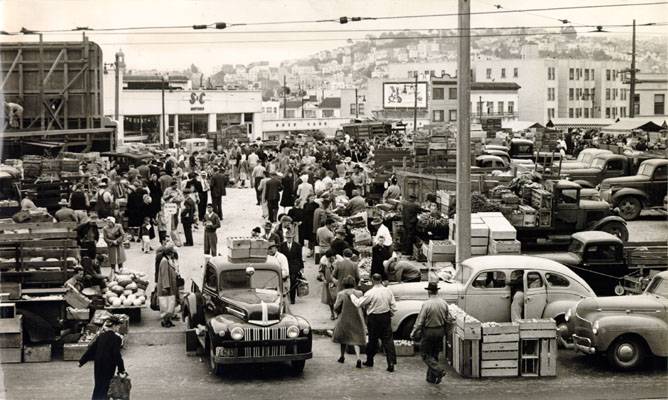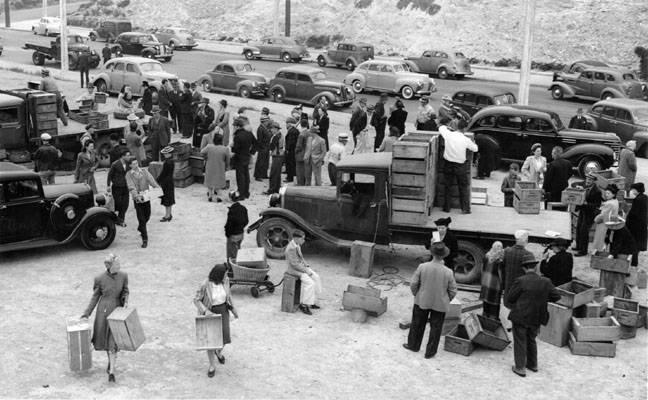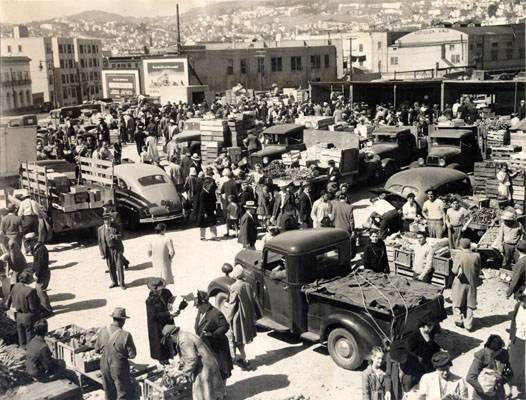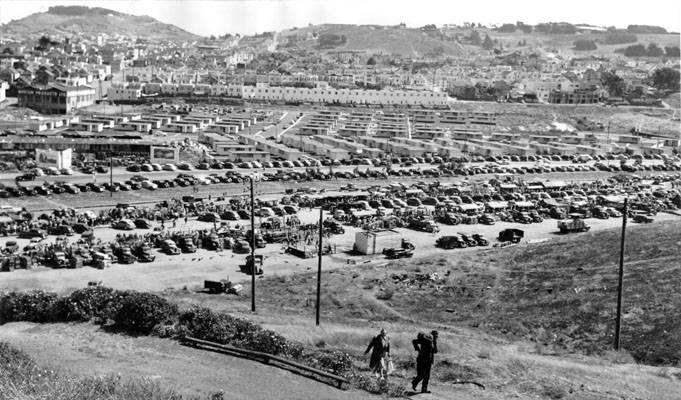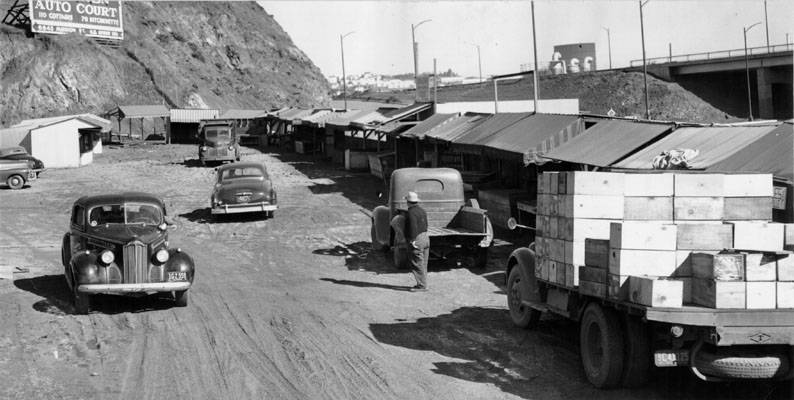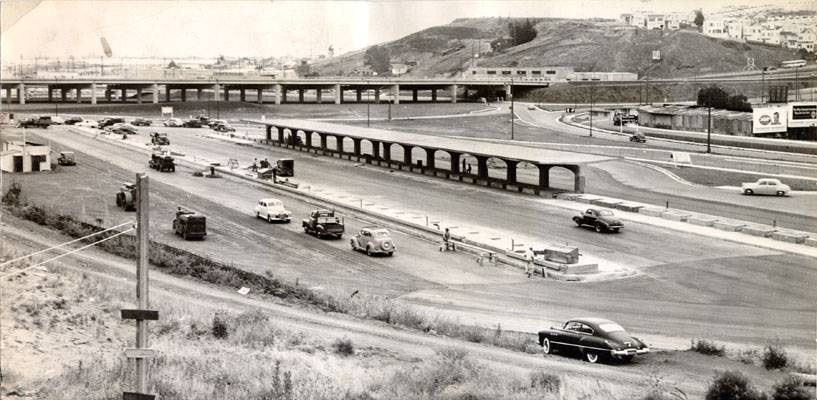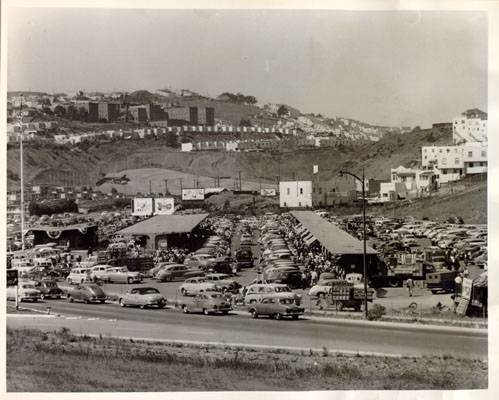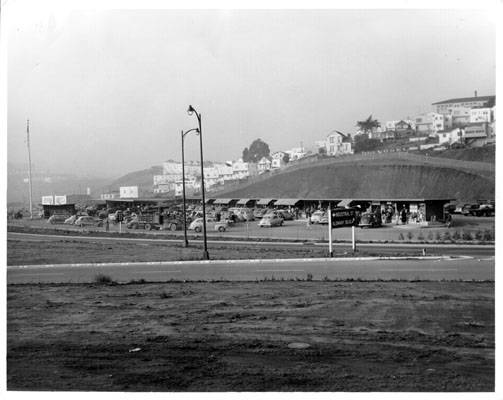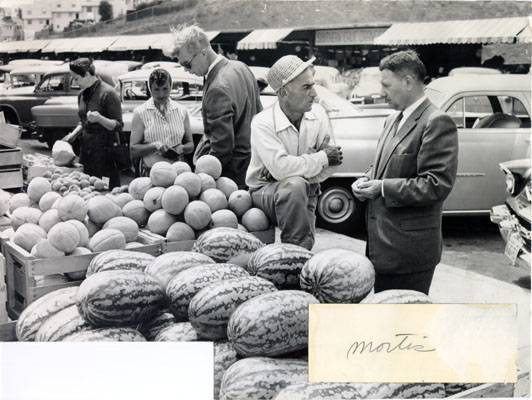SF's Farmer's Market
Duboce Farmers' Market, August 2, 1951
Photo: San Francisco History Room, San Francisco Public Library
San Francisco's Famous Farmers' Market
Something happened that was to change our direction into one of the biggest civic enterprises ever attempted by a group of amateurs. It all began when I received a telephone call from Tom Peryham, agricultural commissioner of Marin County.
The pear growers in northern Marin County were in trouble. They could not sell their pears, because the canneries, under wartime pressure, were jammed and couldn't handle Marin County's famous Bartlett pears. Pears in Marin County? Yes, there were 600 acres of choice Bartletts in what is now Novato, Ignacio, and up in the direction of Petaluma in Sonoma County.
For the benefit of the new generations coming on, this was 1943. Marin County, other than San Rafael, was a quiet, rural agricultural county. There was no highway traffic congestion or urban development. These headaches came later.
The pears were rotting on the ground. There were over 300 tons picked and boxed which could not be sold. Canneries were paying 4 cents a pound for choice pears, while pears in the retail markets in San Francisco were going from 17 to 22 cents a pound. We thought, why can't the consumer journey to the source and get the pears cut rate? This is just what we did. Again, with the help of the news media, we publicized the problem and showed people how to get to the Novato area. They were assisted by posted roads with directions on how to get to the various orchards. The price was 4 cents a pound if you brought your own containers.
The response from San Franciscans and the Bay Area was so enthusiastic that the entire 300 tons of pears disappeared in one afternoon. This avalanche of customers encouraged the growers to pick the remaining 400 tons on the trees. As a result, San Francisco housewives saved their precious' 'Blue Points" (rationing coupons), and the little farmers up in Novato thought the whole thing was pretty nice on the part of the city folks.
It was surprising that the people of San Rafael and surrounding communities were not aware of the surplus pears. It wasn't until the rush of buyers from San Francisco and the accompanying publicity that Novato's neighbors arrived to participate in the fruit bargain.
This little lesson on primitive economics started San Franciscans thinking. It was an age-old question. Who's getting all the money between the producer and consumer? They reasoned that something must be wrong with our system of food distribution since they paid such high prices in the city while, within a radius of 35 miles, the farmers couldn't give their crops away.
The Novato experiment was watched very closely by neighboring Sonoma County pear growers as well as those in Santa Clara County. Through the agricultural commissioners and farm advisors, I was beseiged with requests for assistance. The growers there began to shout, "Hey, we, too, have lots of pears and Gravenstein apples. Help us." Our problem was that being wartime, we were on gas rations. The Office of Price Administration (OPA) informed me that no extra gas would be allowed for this purpose. What were we going to do? How were we going to satisfy that pent-up desire on the part of consumers to get fresh fruit? It seemed that all our problems, as big as they were, were always solved in simple ways. What was the solution to this urgent situation where fruit growers were facing bankruptcy because there was no outlet for their fruit? Well, "If the consumer can't go to the farmer, let the farmer come to town." This is how the San Francisco Farmers' Market was born.
Joe Sanchetti was up earlier than usual on the morning of August 12,1943. He had a bumper crop of pears on his trees and quite a few had dropped to the ground. There was no market for his high-quality Sonoma County pears. While the fruit-starved people in San Francisco were paying 22 cents a pound for pears, Joe was lucky to get 4 cents a pound; that is, if there were any buyers. He was too far removed from the consumer. Joe and many other fruit growers in Sonoma, Napa, and Santa Clara Counties heard that farmers were welcomed in San Francisco and could sell their crops directly to the public. There was no middle man, no commission to be paid no consignment sales; just farmer to consumer and pure, hard cash.
The event was highly publicized in the San Francisco news media. My little group of civic-minded citizens negotiated for a vacant lot owned by Gantner, Felder and Kenny, who happened to be morticians. With the help of some of our city officials and the generosity of the property owner, we were able to obtain the full use of the one-acre lot on Market and Duboce Streets in the heart of the city at no cost to us. The morticians even took out the necessary insurance coverage.
The farmers came in on the first day. There were only six truckloads, but they sold out in less than two hours. A box or lug weighing 25 pounds sold for a dollar as most of the farmers had from 40 to 100 lugs on their trucks.
Duboce and Market, Farmers' Market, August 14, 1943
Photo: San Francisco History Room, San Francisco Public Library
We never realized that we would have the immediate opposition of the Wholesale Produce Merchants and the Retail Grocers Association, but we did. Joe Sanchetti, who drove in the first truck, followed by Paul Mancini from Santa Rosa were the first two who dared to oppose the entrenched merchants who did everything possible to stop this' 'newborn infant" the Farmers' Market, from taking hold.
Thursday was a trickle of six trucks and Friday's total was only eight, but on Saturday, all hell broke loose. They came from the north, the east, and the south. First it was fruit and then vegetables. No one really realized the plight of the farmers. They were desperate.
Here it was, wartime, and food was going to waste. My little group of the Victory Garden Advisory Board suddenly became the Farmers' Market Advisory Board. We didn't have a plan. We just tried to help a few farmers sell their crops and at the same time, give the fruit-starved consumer a chance to buy the fruit and vegetables at unheard-of prices. We opened a Pandora's box.
Who ever thought that this six-pronged spearhead would prick the monopoly of the Washington Street Wholesale Produce Commission district? Although fully anesthetized by the morphia of profits, the commission merchants scarcely noticed the first gentle insertion of the economic lance; that is, not until the first Saturday when over 135 farmers sold their fresh-picked produce to an all-day crowd of more than 50,000 people. They came on foot, in cars, and by public transportation.
Duboce and Market Streets Farmers' Market, July 3, 1944
Photo: San Francisco History Room, San Francisco Public Library
Assuming the success of this unplanned venture, our next stop was to have the city take over. It required eleven months before our citizens' committee convinced the supervisors that this was to be the function of the city. We, as civic-minded citizens, with the backing of the news media and the general public, had no choice. We kept the market going by forming a combined farmers and citizens committee, which I headed. We insisted on tight inspection by the agricultural commissioner, Bill Carroll, who was to be a thorn in our side for years to come.
After much deliberation, the Board of Supervisors reluctantly accepted the Farmers' Market as a legitimate part of the city's food distribution system. In the eleven months of infighting, intrigue, and political opposition, six of the eleven supervisors fought us tooth and nail with the assistance and insistence of the powerful wholesale merchants and retailers officials. I must have appeared before the Board of Supervisors at least once a week during that period.
The Farmers' Market became a reality only because the news media and the public were on our side, and because we had to agree to various restrictions which, while detrimental, we managed to live with. The market proved its worth by using its facilities to save surplus crops that would have gone to waste. This was the salvation for many of our California family-size farmers. We did not need the big grower, because he didn't face the problem the little farmer did. His outlet was mainly on consignment, which meant that he never knew when he would be in the black. It was generally the other way around.
Cars parked near Farmers' Market, Duboce and Church, August 2, 1947.
Photo: San Francisco History Room, SF Public Library
A public opinion poll was conducted which showed ten-to-one in favor of a permanent Farmers' Market. We knew that if we placed the question of a permanent Farmers' Market on the ballot, we would encounter strong opposition. Again, the most powerful opponents were the Wholesale Produce Merchants and the Retail Grocers Association. Strangely, it was mainly the retail association officials, along with the produce group, who were putting up a fight.
As a citizens' group, we had no funds. Our opponents had a half-million dollar war chest. The Farmers' Market matter was placed on the ballot. Without going into the many details involved, the citizens of San Francisco responded with a 145,000 to 25,000 victory. The seven-to-one verdict was the highest margin of votes ever to be garnered on a policy matter in San Francisco. Although we were quite elated, we were not so naive as to think that our troubles were over. As a matter of fact, they had just begun.
Our opponents didn't give up. They merely regrouped and formed a campaign committee against tax subsidization of the Farmers' Market. Chairman of the group was Frank Tissier, secretary of the Retail Grocers Association. William Hadeler, state secretary of the association, was the other front man. Their plan was to convince the retailers that the Farmers' Market would put them out of business. To this, I replied at a standing room only hearing before the Board of Supervisors that, "If the Farmers' Market was responsible for one retail clerk losing his job, I would take immediate steps to close the market." Strange as it may seem, I was never challenged. In fact, many smaller retail grocers were seen at the Farmers' Market early on Saturday morning buying their' 'shorts" or the very freshest from the fields.
The second campaign started four months before election day. I, as the farmers' leader, was singled out as a radical, Communist, and many other' 'affectionate" names. The more they attacked me, the more support we received from the many civic groups and the public. Then came our big break. Joseph L. Alioto, a former special assistant to the U.S. Attorney General, invited me to lunch. He was the prosecutor for the government against the Retail Grocers Association, which had violated the Sherman Anti-Trust Act and robbed an unsuspecting public during wartime for its personal profit.
Over a two-year period, the San Francisco consumer was saddled with an extra cost of almost $2 million in his grocery bill, which was a lot of money in those days. I learned from Alioto that on March 4, 1942, William Hadeler and Frank Tissier were indicted by a Federal Grand Jury in San Francisco as the principals in a conspiracy to fix prices of foods, groceries and allied products at unreasonably high levels, within a territory extending from San Luis Obispo to the Oregon border. (Dean David Snodgrass of Hastings Law College was the foreman of the Grand Jury.)
These defendants and others went to trial before Judge Michael J. Roche and were found guilty as charged. They paid a heavy fine, lost their appeal, and went to the Supreme Court which refused to hear the appeal. These, then, were the men who had the gall to come out in this campaign to protect the assembly district in San Francisco—a district that had twice voted for the Farmers' Market. He also noticed that many were sent within a few minutes of each other, so he wired some of the people whose names were signed to the telegrams. They denied that they had ever sent them. Maloney presented the phony telegrams to the Legislature. Needless to say, we won an overwhelming victory.
Leaving the assembly chamber, we ran into Hadeler. He was heard to say, "This is the last time I will be pulling their chestnuts out of the fire," referring to the Wholesale Produce Merchants. We never heard from him or Tissier again.
Alemany Farmers' Market, August 18, 1947
Photo: San Francisco History Room, San Francisco Public Library
The new Farmers' Market, now owned and operated by the city on city-owned land at Alemany Boulevard and San Bruno Avenue, opened to the public on August 4, 1947. It started as an open-air market; the sheds came later.
The first week of operation attracted more than 80,000 people. They purchased more than 125 truckloads of fruits and vegetables on one Saturday alone. Consumers came from a radius of over 50 miles from San Francisco, while farmers came anywhere from the Coachella & Imperial Valleys in the south to the potato-growing Klamath Basin in the north.
Alemany Farmers Market, February 13, 1951
Photo: San Francisco History Room, San Francisco Public Library
Our die-hard opposition, in the meantime, began to mount. They worked through the agricultural commissioner's office in which the inspectors actually framed some unsuspecting grower, citing him for selling inferior fruit. Just to cite a classic example, Bill Carroll, our "beloved" commissioner, assigned two of his agricultural inspectors to get the goods on Chet Monez. Chet was a first-class farmer, who operated more than 200 acres of diversified fruit in Solano County. He was also one of my active members on the growers' committee who constantly worked for the good and welfare of the Farmers' Market. He was noted for his high-quality, fresh-picked fruits. Chet was a key target for Bill Carroll. Embarrassing Monez would definitely affect the market.
Of the 2,500 boxes of fruit brought in by Chet in the past three weeks, the inspectors found 14 boxes of so-called "inferior" or "below standard" fruit. The advisory board considered the market at stake in this issue. I asked an old friend, John Molinari, a former assistant district attorney, to defend Chet.
John Molinari was quite familiar with the goings on in Bill Carroll's office. All this fanfare seemed to surprise Carroll, who apparently thought that Chet would plead quilty to the charge, resulting in negative publicity about the market's so-called "low quality" produce. Molinari confused the inspector on the witness stand. He couldn't remember whether he had inspected a packed box or a loose box, as well as other incidents.
The case, after several postponements, was dismissed. There were other petty cases that met with the same fate. (Later, John Molinari went on to become Presiding Judge on the State Court of Appeals.)
As time went on, these farmers became my family. They discussed their problems with me as I listened and smiled, but I never gave them any advice. They seemed satisfied just to get the problems off their chests.
Farmers have a way of dealing with customers. One of the big problems was the squeezing of a tomato or peach by a consumer to determine whether it was ripe. This, of course, was rather annoying as no doubt, it was harmful to that tomato or peach.
Mike Cozzolino, a tomato grower from San Mateo County, had the perfect solution. Over one box of tomatoes, he placed a large sign which read: "Tomatoes for squeezing." The customers got the message. "Some of them would try to squeeze a coconut," confided Mike.
Alemany Farmers' Market, July 3, 1951
Photo: San Francisco History Room, San Francisco Public Library
A sprinkling of appreciative seasoning, it seems to me, is an appropriate garnish for a potpourri. Some three years after the opening of the Farmers' Market, Mrs. Emilio Giovanonni beckoned me from her stand. She said, "I just wanted to thank you for buying us our brand new Dodge truck." This puzzled me until I noted the twinkle in her husband's eyes. The artichoke grower from Half Moon Bay then told me that this was one of the many benefits the market had brought them.
The Farmers' Market was not the solution to the high cost of living. It was, however, one of the many steps that could be taken to decrease prices and supply quality, fresh-picked, vitamin-filled foods. It was never designed or created to eliminate the middleman. He has a definite place in our food distribution system, which needed a thorough clean-up.
Too much food is destroyed in order to maintain high prices. There is too much emphasis on high quality standards for our foods, and we neglect giving the public its choice of the good lower grades at low prices. But if we are to be a healthy, well-fed nation, we had better start doing this right now before we starve to death in this land of milk and honey. There was no shortage of food in this country. There was no overproduction and there was no surplus. The problem was with the distribution methods.
Something besides nature had gone wrong in these times of so-called overproduction. If the people were given the chance to absorb this overproduction at fair prices, there would have been enough food for all with some to spare.
Five years have passed since Joe Sanchetti arrived in San Francisco with his pears. You, who have read this far, will agree that those pears were indeed the fruit of controversy. During these years, we fought hard to make Joe's stay a happy and permanent one.
Alemany Farmers' Market, 1953
Photo: San Francisco History Room, San Francisco Public Library
Now, after the fifth year, I can happily say that The Farmer Came to Town and like The Man Who Came to Dinner, he stayed.
The first five years was a period of establishment, controversy, and a struggle for survival. It all happened without a plan. One thing followed another and happily, we survived.
We established a civic enterprise that was a credit to the city of San Francisco and perhaps one of the greatest accomplishments in the history of urban-rural relations. The farmer felt at home, and likewise, the city consumer responded in ever-increasing numbers as judged by the Saturday crowds. They now came from a radius of 75 miles to meet, shop and chat with the farmers. At the same time, relationships were established that were mutually enjoyed, in many cases, on a first name basis.
We were fortunate that we had a mixture of old and young farmers who did things together. If there was a surplus of cauliflower, they informed me so I could then publicize a surplus sale of large, medium and small cauliflower at an attractive price. We emphasized small sizes, which were never available in the supermarkets, to apartment house dwellers who welcomed buying a small cauliflower. The same approach was applied to apples where small' 'school boy" apples were ideal for the little one's lunch.
Alemany Farmers' Market, 1950s
Photo: San Francisco History Room, San Francisco Public Library
Whenever we managed to get a few lines in the newspapers and an occasional plug on radio and television, this brought out the housewives, or we should say, the “shoppers.” Then, we noted a new type of shopper—people seeking organic vegetables and fruits. The public was concerned that the supermarkets, handling the produce of the large-scale, mechanized, and chemically fertilized crops, could no way carry the organic produce.
What is an organic fruit or vegetable? The Department of Agriculture shied away from giving an official definition. The public became conscious of the small grower, the family-size farmer who, on a smaller scale, was still using manure and green cover crops that were ploughed under; thus, supplying the organic matter and humus necessary to produce a vitamin-filled fruit or vegetable.
Another most welcomed shopper, the “co-op" buyer, came to the Farmers' Market to buy for groups of families or neighbors. Gradually, the student co-op groups from the Bay Area colleges, fraternity houses, rest homes, small restaurants, and the increasing number of younger couples came looking for fresh-picked, vitamin-filled produce. It was a changing scene.
Perhaps the biggest change took place with the influx of Asians, Africans, and the many Arabic groups who shopped early, generally at daybreak and in the early morning. This augmented the old-time Europeans who also preferred to shop during the early hours of the morning.
Our struggles with our adversaries had come to an end. I constantly warned the growers not to be naive and let their guards down. We had to protect what we had gained. This was not an easy task to keep the farmers informed. I put out my semi-monthly newsletter which was distributed to all the stall holders, and we also had occasional meetings.
With the approach of the 25th anniversary since the founding of the Farmers' Market on August 12, 1943, we decided to celebrate this Silver Anniversary. I appointed Frank Helbing, president of the Apartment House Owners Association and a prominent member of my Farmer's Market Board, as chairman of this colorful civic event.
There was a gala celebration with more than 50,000 attending, causing a half-mile back-up on Alemany Boulevard. The crowds were efficiently handled by the police and special officers. It looked like a county fair. Prizes were given out for the most attractive decorations. Each farmer was permitted to decorate his stall based on what crops he produced. This was rather unique and developed into quite a challenge. A grape grower would decorate with grape vines, leaves and clusters of grapes. Some would add a wine press or a grape crusher. An artichoke grower would use plants with the artichokes attached to the vine. It was up to their own imagination. National attention was garnered for their displays of talent and originality.
It was a beautiful, warm San Francisco day as everyone enjoyed the music of the municipal band and the street-strolling musicians. Eleven boys' clubs entered a watermelon eating contest, with Mayor Joseph Alioto awarding the prizes. The highlight of the festivities was a luncheon held at the Sun Valley Dairy adjacent to the Farmers' Market. Vince Palmieri and his wife, Josephine, along with co-partners Ben and Doris Teshera, hosted this annual affair for our citizens' committee, farmers, and civic dignitaries.
That following Wednesday, a banquet was held in my honor at the San Francisco Press Club on Post Street. It was sponsored by the Municipal Executives Association of which I served as president from 1956 to 1957. There was a capacity crowd of 350 people. Joseph Allen was master of ceremonies as the Honorable John B. Molinari, Presiding Judge of the California Court of Appeals, made my introduction.
The mayor of San Francisco, Joseph Alioto, was the speaker of the evening. He played an important role in the formulative years of the Farmers' Market, especially during our continuous problems with the Wholesale Produce Merchants and the Retail Growers Association. Others in attendance included Thomas Mellon, the chief administrative officer, many city, state and federal officials, civic dignitaries, and those representing the Farm Bureau and other agricultural bodies. It was quite a memorable affair.
--John Brucato, from his memoir A Sicilian in America (Green Hills Publishing Co., Millbrae CA, 1992)
The Farmer still comes to town
John Brucato (in suit at right) at Alemany Farmers' Market, 1950s.
Photo: San Francisco History Room, SF Public Library

